- Home
- Blog
- Social Media Why Your Marketing Team Should Use Tumblr [INFOGRAPHIC]
Why Your Marketing Team Should Use Tumblr [INFOGRAPHIC]
-
 24 min. read
24 min. read
-
 WebFX Team
WebFX Team Digital Marketing Agency
Digital Marketing Agency
- The WebFX team is made up of more than 450 subject matter experts in digital marketing, SEO, web design and web development, social media, and more. Together, they’ve helped WebFX’s clients earn more than $3 billion in revenue from the web — and that’s just in the past five years. @webfx
Tumblr is one of the most niche social networks on the Internet. It’s not as generalized as Facebook, but it’s also not as specific as Instagram. It gives users more free reign than Twitter, but users still have dashboards like Pinterest.
Tumblr is a hybrid social network that’s become its own community — one that has its own jargon, intricacies, and norms.
It also has millions of users and — compared to other social networks — hardly any advertisers. That makes Tumblr a golden opportunity for any marketing team that wants to get the word out about their brand. Now, it’s time to try marketing on Tumblr!

Tumblr terms
Before we jump into Tumblr’s worth for marketing, we need to talk about Tumblr-specific jargon. 
On Tumblr, a note is any interaction that someone takes with your blog or ad. Typically, that’s shown as a comment underneath your blog.
A like is a standard indication of appreciation or agreement, just like on Facebook. It doesn’t necessarily mean someone “likes” the topic. A reblog is Tumblr’s version of a share, like a retweet on Twitter.
Last, a tag is a categorical indicator of content. So posts marked “food” will be about food, “fashion” will be about fashion, and so on. With these terms in mind, let’s jump into some standard Tumblr stats.
Tumblr stats
Tumblr is one of the lesser-known social networks in the world.
But surprisingly, it has a massive user-base that consists of eager, excited, and loyal users. At the time of publication, Tumblr isn’t even 10 years old yet. So let’s take a look at how Tumblr has evolved since 2007. 
Tumblr first launched in February 2007. Over the next six years, it built up an exceptionally young and passionate user-base that persists to this day. Perhaps that’s why Yahoo!
saw so much potential in it. On June 20, 2013, Yahoo! bought Tumblr for $1.1 billion — $100 million more than what Facebook spent for Instagram.
For about a decade, Tumblr has racked up an impressive number of user stats as well. It has:
- 300 million+ blogs
- 134 billion+ posts
- 550 million monthly users
- 120,000 daily signups
- 53.3 million daily posts
- 1.17 billion weekly pageviews
Plus, Tumblr’s users are huge fans of one another’s content. They actively reblog each other’s posts about 14 times, which is surprisingly high considering average retweets and Facebook shares. But the best stat of them all is last — sponsored posts get reblogged 10,000 times on average!
That’s because Tumblr users love brands that speak their language. When your brand gets on Tumblr’s level, you can promote your business like never before. But how can you be sure users will see you?
And who will see you? 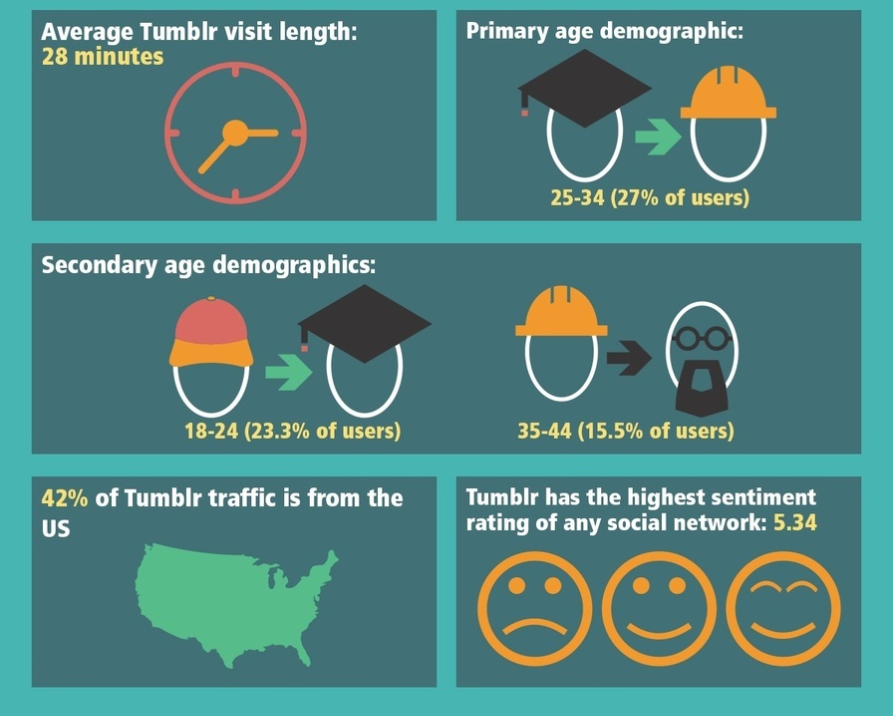
On average, Tumblr users spend 28 minutes visiting their dashboard and interacting with the community at large. Primarily, 25-34 year olds use Tumblr the most (27% of all users).
After that, 18-24 year olds (23.3%) and 35-44 year olds (15.5%) make up secondary user demographics. And beyond that, almost half of all Tumblr traffic comes from the US! But best of all, this batch of stats proves that Tumblr users aren’t your average group of social media enthusiasts.
Tumblr has an overall sentiment rating of 5.34, which is far higher than most others — especially Facebook. Tumblr’s hands-off policies have made it exceptionally popular among privacy-conscious users, and Tumblr only just started introducing its users to ads. And speaking of Tumblr users, let’s take a closer look at them.
Tumblr users
Tumblr has a rich, diverse range of users that make it the perfect place for marketers.
The first major point you need to know about Tumblr users is that they’re mobile. 78% of all Tumblr users access the site via mobile devices.
On top of that, Tumblr users are fiercely loyal to Tumblr itself. 70% of all users say that their user dashboard is their favorite place online. Tumblr users buy, too. 68% of them shop via ecommerce to get what they want. 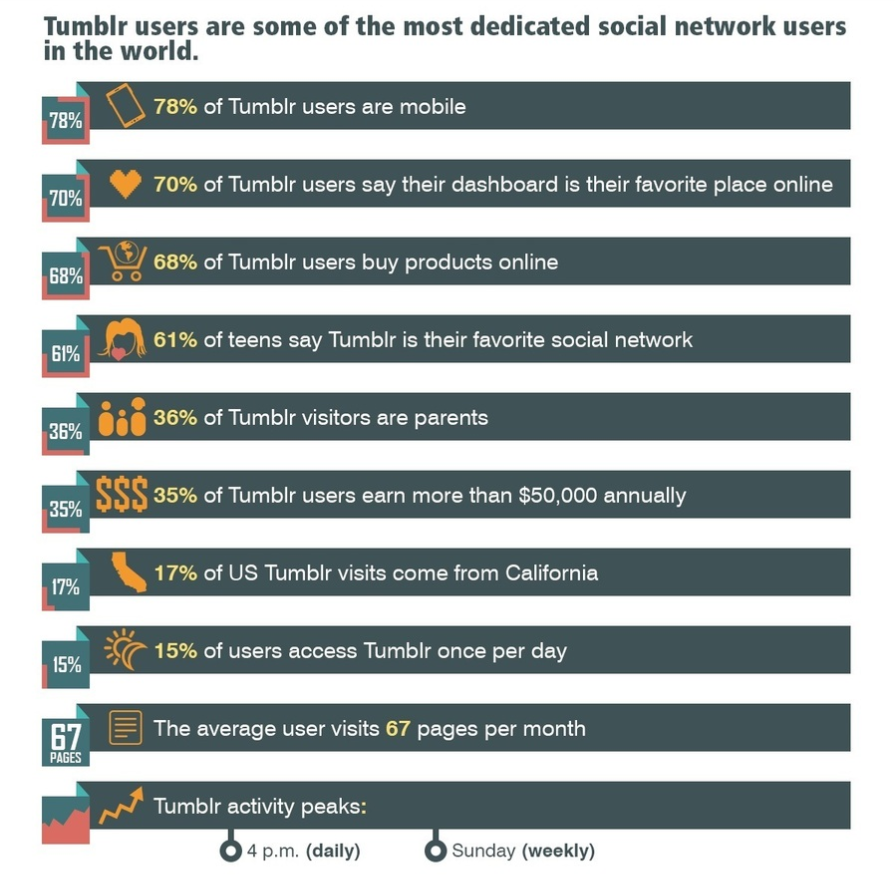 Tumblr’s also remarkably popular with teens. 61% of polled teens say that Tumblr is their favorite social network, far outpacing Facebook, Twitter, and even Pinterest.
Tumblr’s also remarkably popular with teens. 61% of polled teens say that Tumblr is their favorite social network, far outpacing Facebook, Twitter, and even Pinterest.
If that trend continues, that means Tumblr will have the most high-value audience of wage-earners in the world — unless another social network gets more popular. In conjunction with its popularity among teens, 36% of Tumblr visitors are parents. Whether they’re looking for parenting tips or just fun content is another question.
Tumblr’s users are also fairly wealthy. 35% of them earn more than $50,000 annually. But Tumblr is also highly regional. It’s most popular in California, which accounts for 17% of all Tumblr visits.
Many of its users aren’t happy with just accessing Tumblr once per day, either. 15% of them use Tumblr at least twice. And during those visits, Tumblr users check out 67 pages per month. That’s a little more than two per day!
Finally, if you’re going to market on Tumblr, you need to know the best times to reach your audience. That turns out to be 4 p.m. daily — just after high school lets out — and Sunday weekly.
However, that doesn’t mean 4 p.m. on a Sunday is the absolute best time to reach an audience. Instead, you should look for when your demographic is on Tumblr.
That will give you a much better idea of when you should share and promote posts.
Popular content on Tumblr
As with any social network, some content tends to succeed better on Tumblr than others. Fortunately, this content is trackable. And with it, you can create Tumblr-specific content that resonates with your target audience.
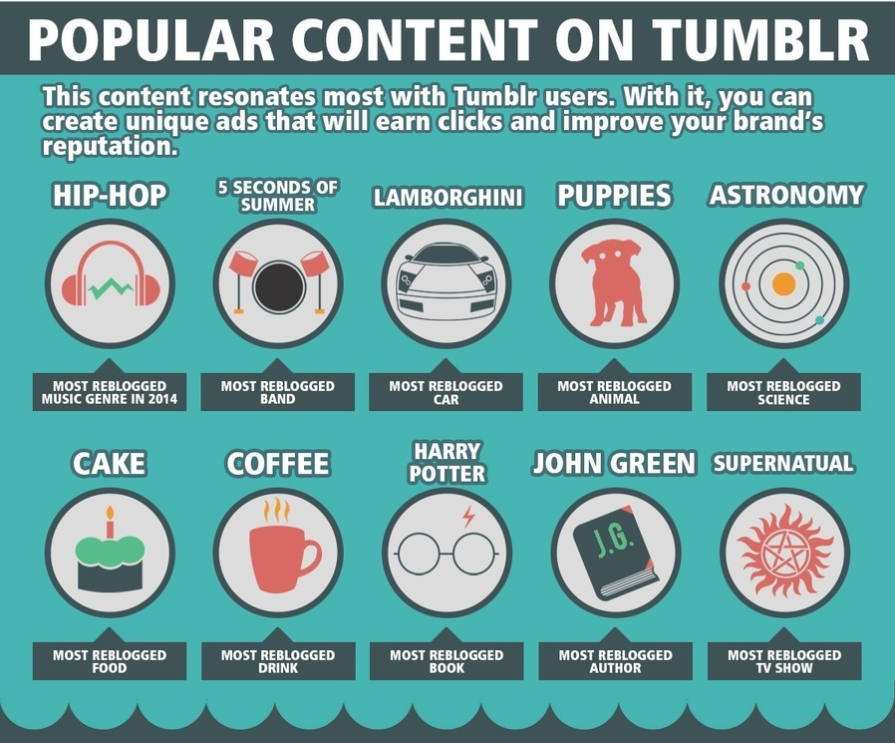
It’s important to note that this list of top content isn’t in any particular order. Hip-hop isn’t necessarily more popular than puppies, and Harry Potter isn’t necessarily more popular than Supernatural (although they’re definitely similar). It’s also important to look at this content from the perspective of the people who enjoy it.
All of this content points to younger people (5 Seconds of Summer, Harry Potter) with romantic ideologies (John Green) who enjoy mind-blowing science (astronomy), cute animals (puppies), and daydreams of a wealthy future (Lamborghini). In that respect, Tumblr isn’t so much a group of people as it is a single communal entity. One person can possess all of the traits we’ve listed above.
In fact, if you know a lot of people between the ages of 18 and 34, you probably know someone who fits this profile perfectly. It’s the person who’s enjoying their life, not necessarily making lots of money, but not necessarily poor either. They enjoy absurdity as much as they enjoy cold-hard facts, and they drink just as much coffee as a trucker without any of the justification.
They’re romantic. Flighty. Prone to fancies.
And, even if they haven’t read a book in 10 years, they own lots of them. The common Tumblr community member is what most people today would call a “hipster.” And whether you buy into that classification or not, you can use the above information in conjunction with the next section to make your brand more popular on their social network of choice.
Top Tumblr tags
Tags are ways for users to classify their posts on Tumblr. If something is funny, a blogger can post it under “lol.” If it’s stylish, they can post it under “fashion.” These 10 Tumblr tags have the most participation.

Most of these are pretty self-explanatory, but we’ll give a brief explanation for each.
- lol — used for anything funny
- fashion — used for anything personally stylish, such as clothing or accessories
- food — used for anything showing food
- art — used for anything artistic, typically visual arts
- vintage — used for anything that’s a throwback to another time
- landscape — used for anything showing nature
- tattoos — used for anything showing a tattoo or skin brand
- black and white — used for anything that’s depicted as black and white or grayscale
- makeup — used for anything that describes makeup
- illustration — used for anything that’s personally drawn
When you use Tumblr, these tags can make or break your marketing ideas. Tumblr users can navigate the whole social network with these tags, enabling them to find content similar to what they’ve already liked. So if you want to make sure your company can build a following on Tumblr, start using a few of these 10 tags.
You can even combine them with your own tags — like your company name — to promote your brand even more. An ideal combination would be posting something funny that also relates to your brand. Then, you could tag it with #lol and #[your company name] to make it work for your purposes.
With that kind of one-two punch, you can start getting some significant returns on Tumblr.
Advertisers on Tumblr
There aren’t a lot of advertisers on Tumblr. But for those few early adopters, they can enjoy some incredible results from one of the world’s youngest and hippest social networks.
When it comes to brand sentiment, Tumblr is the #1 social network in the world. 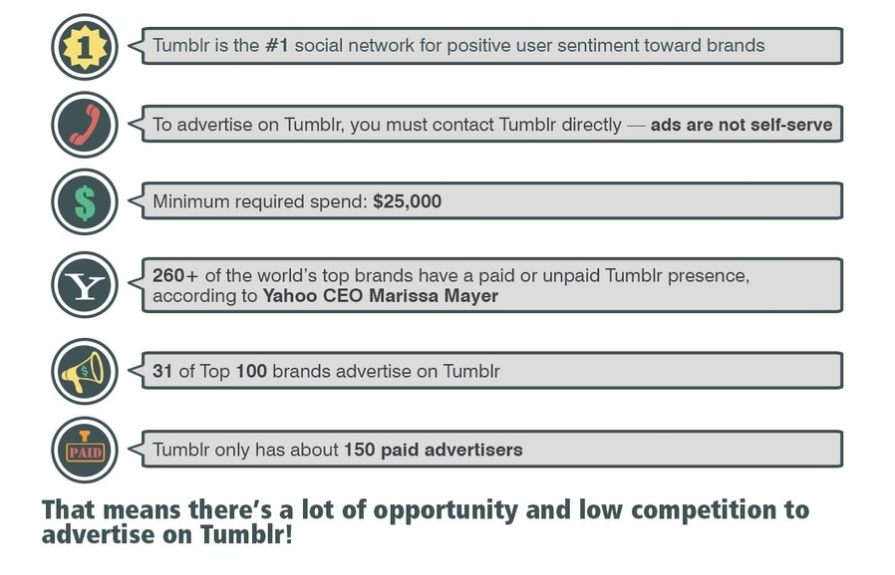 In other words, Tumblr users love brands.
In other words, Tumblr users love brands.
Typically, that means brands that know how to post interesting, Tumblr-worthy content. But it can also relate to companies in general. Fashion, food, tattoos, and makeup are all top tags on Tumblr — and you can’t have any of those without brands to back them up!
Still, there are two big obstacles to advertising on Tumblr. The first is that you have to directly contact Tumblr to start advertising. That’s a bit of a pain for most Internet marketers, if you’ve gotten used to the self-service nature of Twitter, Facebook, and Google AdWords.
But even after that, the initial investment cost is pretty steep for smaller companies — a cool $25,000. Even in the face of a $25,000 investment, Yahoo CEO Marissa Mayer is still confident about Tumblr’s appeal to brands with 260 of the world’s top brands having a paid or unpaid presence on the social network. 31 of those businesses are Top 100 brands as well. But at the end of the day, Tumblr only has about 150 paid advertisers.
You may think that’s an incredibly small number, considering how many people use Tumblr — and you’d be right. But really, that means Tumblr is an ad medium with high opportunity and low competition. If you can afford the initial cost, you can grow far more quickly and effectively than your competitors by adding Tumblr to your social media strategy.
Tumblr success stories
We wouldn’t talk about why Tumblr is a great marketing tool if we didn’t have at least a few examples.
The five case studies below cover a wide range of companies and industries. They’re all fairly big brands — mostly because of Tumblr’s high initial cost — but they also earned substantial returns for their investments. But we’ll let the case studies speak for themselves.
Case study #1: ASOS
ASOS is a British fashion staple that prides itself on taking the next steps in general fashion.
The company features everything on its site from prom tuxedos to the next generation of casualwear. Since ASOS constantly tries to stay on the cutting edge, they want to reach the youngest audience that they can. Advertising on Tumblr was a no-brainer.
And so was the content of their Tumblr campaign. 
They want to reach an audience that’s on the cutting edge of fashion — people who are inherently creative and looking for (or to make) the next big trend. So ASOS hosted a contest where Tumblr users designed new shirts for the company.
They got 900 new designs, and they chose four to produce. After producing them, everyone — including ASOS — was shocked to see how quickly they sold out. The company’s entire stock of user-generated shirts were gone within 10 hours.
For ASOS, this is about as good as it gets. First, Tumblr users designed the shirts for ASOS, meaning they didn’t have to use design resources. The company just had to sift through all the designs they got.
Second, ASOS knew there would be a market for these products since their customer base designed the shirts already. Nobody would design a shirt that they wouldn’t want for themselves. Third, ASOS got the perfect product for continued production.
If a shirt sells out in 10 hours, it’s clearly worth keeping around to at least re-release occasionally as a limited offer, kind of like the McRib. Last, ASOS got a ton of new fans and customers by crediting each individual person who produced a winning design. The creators’ names are permanently attached to their designs on the ASOS website.
With those four qualities, ASOS made itself one of the most approachable and relatable clothing brands online — not to mention all the money they made.
Case study #2: FX
FX is a television station that produces more experimental and risky shows than most other networks. The station itself is famous for hit shows that push the envelope like It’s Always Sunny in Philadelphia and Archer. The whole station has a definite “indie” vibe to it, and it has a young fanbase throughout the world.
So to promote its new show, Man Seeking Woman, FX took to Tumblr. 
Since FX wasn’t pushing a product that people could literally buy, they had to look at less tangible metrics to measure their success. But even without specific dollar amounts in the mix, FX created a successful campaign that clearly resonated with Tumblr users.
The first indication of their success is their engagement rating. 2.8% engagement is fantastic for any digital ad medium. With all of Tumblr’s users, that’s still a lot of people clicking, commenting, or sharing FX’s ad. FX also earned an 86% increase in its Tumblr followers.
That gave them a young, hip market to which they could consistently market — for free — later down the road. But FX didn’t just earn more — they also saved more. By using Tumblr, they managed to save 42% on earned media costs.
That means they reached thousands of new fans, nearly doubled their following on a social network, andreduced a big chunk of their marketing budget by half. That’s an impressive report all around. And for those wondering, Man Seeking Woman got renewed for a second season.
Case study #3: SweeTARTS
Compared to FX, SweeTARTS has a super-simple business model.
Objective: Get people to eat candy. Method: Market to people who like candy. The product practically sells itself.
Granted, it can be difficult to get people to buy sweets when we live in such a health-conscious world. But at the end of the day, there’s always going to be someone who wants a packet of candy. p>And thanks to SweeTARTS, we have proof.

SweeTARTS decision to market on Tumblr could have come from any number of reasons. Candy itself is a universal pleasure in that there’s no set of obvious or outwardly-physical circumstances that could keep someone from buying it. Poor people like candy.
Rich people like candy. Old people like candy. Young people especially like candy.
SweeTARTS invested in Tumblr advertising to capture that last demographic. Their investment yielded incredible results, too. On Tumblr, SweeTARTS got 9.8 million impressions on its ads, along with a 410% increase in followers.
Better yet, they had a 1.05% engagement rate. Based on their number of impressions, that’s 102,900 engagements. All in all, this simple candy company saw a huge increase in followers while reaching 102,900 people that it otherwise could’ve missed without Tumblr.
That’s a lot of new potential customers picking up candy. If every one of those customers spends just $2 on SweeTARTS, the company has made nearly a quarter of a million dollars — or 10 times their initial investment.
Case study #4: Universal Studios
In the film industry, hype is everything. Building anticipation for films is the best way to sell them — especially when you’re hyping a movie that’s suspenseful.
Universal Studios had that idea with the film Ouija. It came out in 2014, and the suspense thriller focused on a group of young people trying to talk to their recently-deceased friend. It’s a simple plot, and it’s relatable for anyone who’s ever lost a friend — or even thought about it, really.
So to get more viewers for the film, Universal Studios reached out to young, passionate fans through Tumblr. 
Universal Studios took to Tumblr with the exclusive goal of getting more viewers (and revenue) for their film. And on Tumblr, they earned success.
Their investment yielded a total of 625,000 engagements across the social network — far more than any other ad on this list. On top of that, Universal Studios got 299,000 notes on their ads. And altogether, it led to a 28% reduction in earned media costs for the company.
And better yet, Ouija raked in $20 million at the box office — quadruple its original budget. In 2014, say that the average movie ticket cost $12. If every one of Universal Studios’ engagements related to a new movie ticket — which isn’t exact, but reasonable — then the studio earned $7.5 million just from Tumblr. At a baseline $25,000 investment, that’s a return of 300 times the original cash spent. And it’s worth noting that Ouija didn’t get particularly good reviews — it just earned money from the power of promotion.
Case study #5: Visit Britain
Visit Britain is a tourism agency that wants to get people to… Well.
Visit Britain. They didn’t have a time-based goal — they just wanted to scare up some new leads on young travelers who want to see the world. With that goal, they took to Tumblr.

Visit Britain’s investment in Tumblr paid off in big ways. First, they got a 200% increase in blog impressions, meaning 200% more people saw their blog than normal. They also got a 100% increase in organic engagement.
That seems to indicate that paid Tumblr ads can have an impact even beyond ads themselves — they can engage users on the organic level, too. And, like some of our other case studies, Visit Britain saved 40% on earned media costs. For a lead-based company, those are all impressive stats.
They all increase the likelihood that someone will recognize their brand, contact them directly, and set up a trip through the agency. In B2B terms, that kind of probability is worth its weight in gold. Anything you can do to get more leads — and clients — is a smart bet from a B2B standpoint.
With that mentality, Visit Britain succeeded.
How to reach customers on Tumblr
Like most other Internet advertising outlets, Tumblr has a few options you can use to reach potential customers. The first option is sponsored blogs. 
Sponsored blogs are accounts that you create on Tumblr and then pay to promote among Tumblr’s users.
That makes your blog show up in user feeds, ensuring plenty of people can see your company’s logo and click to your new blog. This format is especially useful for building your following on Tumblr. Then, you can freely market to your followers for free, right from your Tumblr account.
In that respect, this ad style is similar to Facebook’s option to promote your business page. You pay to get more followers, and then you can market to those followers an infinite amount of times — and for free — further down the road. If you plan to create a consistent, strong presence on Tumblr, this option is the best for you.
are brief blog posts that you create.
Then, you take those posts and pay to promote them among your primary sales demographics. 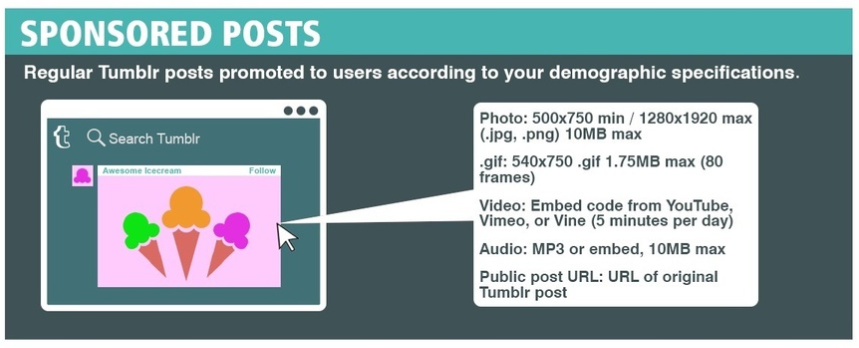 When you use sponsored posts, you can get the best results by promoting specific products or services that users need to purchase in order for you to see returns. These posts can work for everything from television shows to smoothie shops and more.
When you use sponsored posts, you can get the best results by promoting specific products or services that users need to purchase in order for you to see returns. These posts can work for everything from television shows to smoothie shops and more.
You just have to stay on point and show exactly what your customers can expect to get for their money.
are custom-made posts that you can purchase on Tumblr without the need to create a blog first. 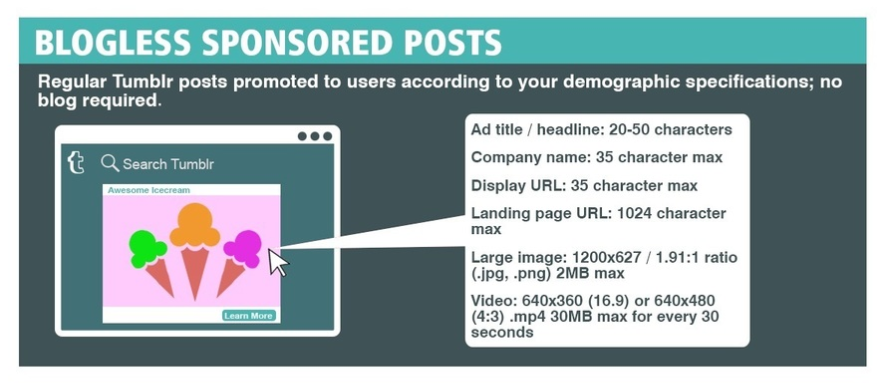 These kinds of posts are perfect for companies that want to sell a product or service but don’t want a Tumblr blog of their own. In other words, this is the perfect ad for a company that wants to test the waters of Tumblr or maybe try out a new product designed specifically for Tumblr’s young age demographic.
These kinds of posts are perfect for companies that want to sell a product or service but don’t want a Tumblr blog of their own. In other words, this is the perfect ad for a company that wants to test the waters of Tumblr or maybe try out a new product designed specifically for Tumblr’s young age demographic.
are another ad option.
They’re almost identical to sponsored blog posts, except you have a video play instead. 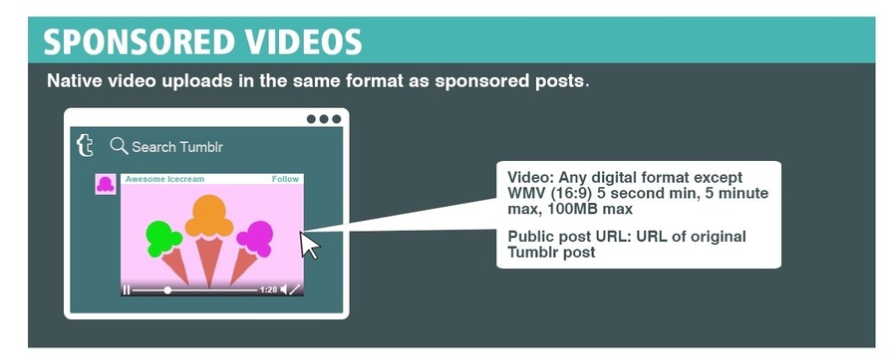 As long as your video adheres to Tumblr’s ad guidelines (which we’ll discuss later), you’re in the clear to post any video you think will resonate with Tumblr users. Does your company make energy drinks?
As long as your video adheres to Tumblr’s ad guidelines (which we’ll discuss later), you’re in the clear to post any video you think will resonate with Tumblr users. Does your company make energy drinks?
Publish a high-octane, adrenaline-rush video of skydivers plummeting over Pacific islands. Are you a college? Create a video that shows your diverse areas of study and highlights your accomplished students.
No matter what you do or what you sell, sponsored videos are a great way to show Tumblr users the impact and advantage of your business. Sponsored days are Tumblr’s most unique ads. They let you add a logo and tagline to any user’s dashboard, as long as they fit in your demographic specifications.
You can even take out a banner ad that takes up the top of user dashboards. Your ads will stay on their dashboards for a whole day, allowing you to funnel traffic to your Tumblr blog, website, product pages, or anywhere else you want. That means you can use these ads to work for just about any purpose you need.
And the whole time, you’re at least raising brand awareness since most Tumblr visits start on user dashboards. So for a whole day, the first thing your demographic sees on Tumblr is your image, logo, name, and links to convert. With these five ad styles at your fingertips, earning positive returns on your $25,000 Tumblr investment may take a little time — but they’ll clearly happen.
Tumblr creative guidelines
Tumblr’s creative guidelines are pretty straightforward, and they’re pretty much common sense.
For any reputable brand, you probably do almost all of this anyway. 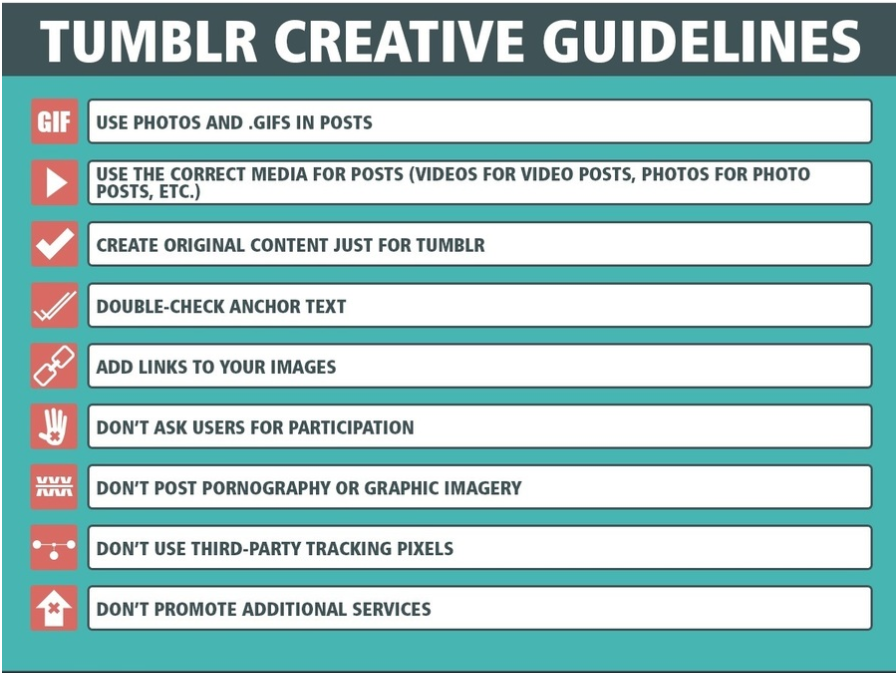
First, use photos and .gifs. These formats have proven to catch on well with Tumblr’s audience.
These small image files should convey your message almost immediately, preferably with some kind of fun or funny undertone. Photos and .gifs that show Tumblr’s most popular content are smart ways to get some eyes on your ads. You can also create high-quality content that you use exclusively on Tumblr, which guarantees that it’ll grab someone’s attention as they scroll.
It’s also critical to use the correct media for posts. This is more of a necessity than a guideline since your ads simply won’t work with the incorrect media. If you’re advertising on Tumblr, then you have to spend at least $25,000 to get started.
Nobody wants to send $25 grand down the drain by taking out a video ad and accidentally supplying a .jpeg. We touched on this briefly earlier, but original content is key to succeeding on Tumblr. Recycling images and statistics that people have seen on other sites won’t have the eye-catching stopping power that you need to appeal to Tumblr users.
On top of that, nobody wants to feel like they’re just another marketing target. If you want to resonate with Tumblr users across all demographics, show them that you understand what they want and like — it’ll pay dividends. Next, and this is just good general advice, always double-check your anchor text.
Anchor text is incredibly important since it tells Tumblr users what to expect from a link. That means if your anchor text isn’t exactly on point with the linked page, you’re essentially cloaking a page on Tumblr. That’ll make your ad seem sneaky, deceptive, and underhanded all at once.
In addition to text links, you also want to add links to your images. Images make perfect, natural buttons for links back to your site. Unlinked images aren’t necessarily the end of the world, but you risk losing customers by not incorporating their preferred linking method into your ad.
Plus, images are much easier to tap on mobile, and Tumblr has tons of mobile users. On the flip side of that, you shouldn’t actively ask for participation in any contests you run. The idea behind this is that the people who want to participate will do so naturally, and the people who don’t will scroll past your ad regardless of whether you actively ask them to join in.
This advice runs counter to what most marketers read and hear about calls to action — if you want someone to do something, the best way to convey that is to tell them. But on Tumblr, subtlety, transparency, and openness are more important than a standard call to action. Next — and most obviously — don’t post pornography or graphic images.
This one is pretty self-explanatory. Less obviously, Tumblr discourages the use of third-party tracking pixels. Tracking pixels aren’t necessary, and using them makes your ad campaign appear tricky, like you’re trying to gather data without user permission or knowledge.
Instead, rely on Tumblr’s in-house analytics and Google Analytics to show you the data you need. There’s very little that a tracking pixel can tell you that both of those analytics systems can’t. Finally, don’t promote additional services on your ad.
Each ad you create should cater to one idea or concept, and any other ideas can get their own ads. Mixing promotions in one ad is confusing, anyway. How is someone supposed to know what’s going on when there are two (or more) ideas in a single ad?
It’s the same reason Charmin doesn’t sell toilet paper and paper towels in the same commercial — it’s far more valuable to stay on point.
Using Tumblr for marketing
Compared to other Internet ad media, Tumblr has a pretty high cost of entry. But with the returns that our five case studies experienced, the investment is clearly worth the returns. So what do you think you’ll do?
Will you use Tumblr for marketing? Let us know on Twitter (@WebFX) or Facebook!
-
 The WebFX team is made up of more than 450 subject matter experts in digital marketing, SEO, web design and web development, social media, and more. Together, they’ve helped WebFX’s clients earn more than $3 billion in revenue from the web — and that’s just in the past five years.@webfx
The WebFX team is made up of more than 450 subject matter experts in digital marketing, SEO, web design and web development, social media, and more. Together, they’ve helped WebFX’s clients earn more than $3 billion in revenue from the web — and that’s just in the past five years.@webfx -

WebFX is a full-service marketing agency with 1,100+ client reviews and a 4.9-star rating on Clutch! Find out how our expert team and revenue-accelerating tech can drive results for you! Learn more
Twitter and Facebook Status Generator
Finding engaging social media content for your business can be difficult. Use our tool to quickly find ideas and post directly to your page.
Give Me an Idea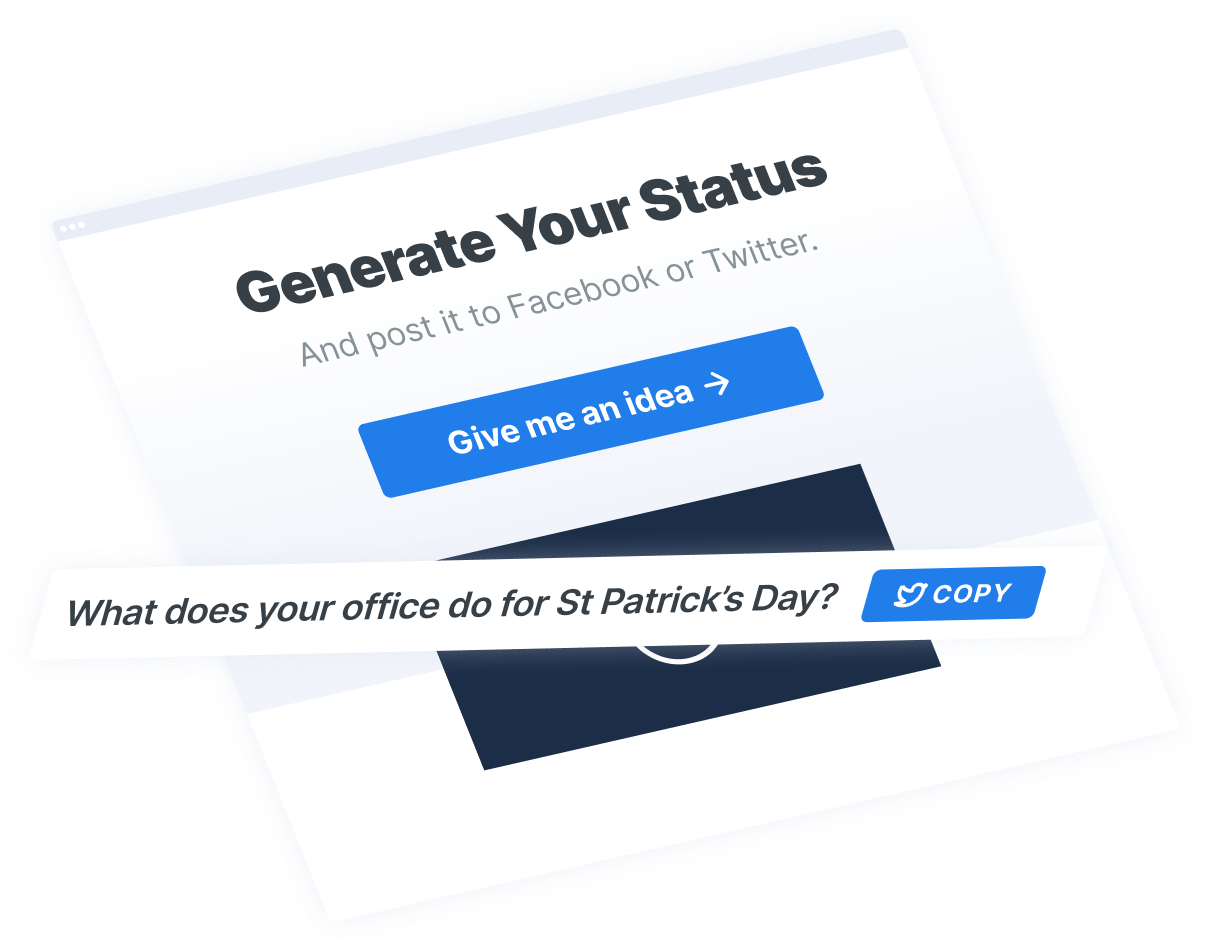

Social Media Cost Calculator
Use our free tool to get a free, instant quote in under 60 seconds.
View Social Media CalculatorTwitter and Facebook Status Generator
Finding engaging social media content for your business can be difficult. Use our tool to quickly find ideas and post directly to your page.
Give Me an Idea





